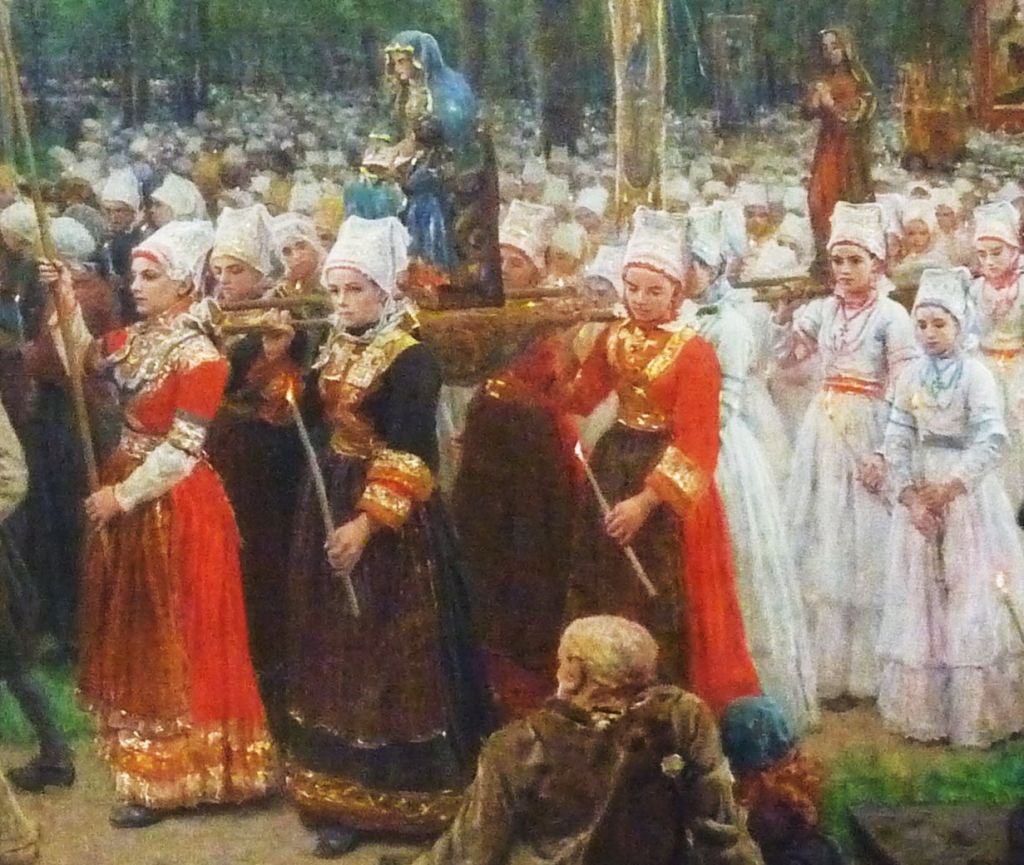The 1880s had been a period of continuing success for Jules Breton. Although concentrating on compositionally simpler paintings, his work was sought-after in Europe and North America, and his poetry was well-received and published. From 1886, though, his health had started to trouble him, necessitating annual visits to the spa at La Bourboule in the Auvergne for ‘the cure’ that never came.
In early 1890, he enjoyed a spell at Cannes to help him through the worst of the winter.

Breton’s last working period in Douarnenez in Brittany was in 1890, when he most probably painted his visionary Young Women Going to a Procession (c 1890) there. A long trail of young women, dressed in virginal white, are making their way through the rolling coastal countryside. Clutching golden fronds (probably of ripe wheat), they are led along the path by a young girl. Further back is a woman bearing a church banner.
The distant hills and cliffs are wreathed in mist, and the whole scene is backlit, casting halos around the veiled heads of the young women. This probably shows a ceremonial procession in association with the rite of First Communion. It was exhibited at the Chicago World’s Columbian Exposition in 1893.

Last Flowers (1890) is unusual in being an early winter snow scene; Breton seems not to have painted outdoor winter scenes during the earlier part of his career, but in the last couple of decades made a few, perhaps when he was more confined to urban environments. This follows on from his full-length portraits of young women in the 1880s, showing a woman using a pair of household scissors to cut the last of the autumn flowers from under their fresh cover of snow. This was bought by Cincinnati Art Museum.

Although Summer is dated 1891, and was shown at the Salon that year, Breton’s original charcoal and chalk study for this was completed in 1887, and is now in a private collection. It is typical of his paintings from the 1880s, showing a lone woman lost in thought at the edge of a ripe wheatfield. His style is here very loose and painterly, with the thistles in the right foreground depicted using gestural marks.

Breton’s last great painting of the crowds at a religious rite was The Pardon of Kergoat in Quéménéven in 1891 (1891). He had accumulated numerous studies, sketches, and probably photographs too showing the masses who attended this small inland village near Quimper in Brittany, on the third Sunday in August, 1891. They came to ask the ‘Virgin of Pity’ and ‘Christ in Agony’ to cure their ailments.
This was exhibited at the Salon of 1891, then at the Chicago World’s Columbian Exposition in 1893.

Breton had made many studies of the gnarled features of older men of the country.

The men’s features are in marked contrast to those of the women: some dressed in red and blue who are carrying the statue of the Virgin Mary, and the more numerous in white who follow on behind, bearing other statues, banners, and more. The huge crowd curves in an arc through the surrounding woods, on into the far distance.

At the Spring (1892) is another full-length portrait, this time of a Breton woman carrying a pitcher of water on her head, after she had filled it at a communal spring. This is set on the Brittany coast near Douarnenez, by the cliffs of Plomarch, and was presumably based on studies made over the previous years.
Breton’s use of a load being carried on the head as a means of producing a fine deportment is reminiscent of The Shepherd’s Star (1887), in which the burden was a sack of potatoes.

Breton seems not to have painted a proper self-portrait until almost the final decade of his life, when he made his Self-portrait of 1895. The painting which he is apparently working on is one of his last showing harvest scenes at Courrières. This was exhibited at the Salon that year under the title of My Portrait.
In 1896, Breton painted another more modestly multi-person harvest scene, Harvesting the Oil Poppies, which was shown in the Salon of the following year.
By 1897, the medical treatment that he was receiving and his many official duties dictated that he had accommodation in Paris, so he bought a house there. At first he and his wife visited it as infrequently as possible, but in 1900 they moved there permanently, giving up the family home in Courrières. He travelled to Amsterdam and Germany in 1897, and in 1899 was made an honorary foreign academician by the Royal Academy in London.
With his steady decline in health and the increasing hostility towards realist art, Breton became depressed in 1903. However, he continued to paint, albeit at a slower pace, and later that year visited Barbizon to paint there too. He also continued to exhibit right up to 1905, the Salon in the year before his death.
On 5 July 1906 he died at his house in Paris.
With the huge changes taking place in painting in the early years of the twentieth century, Breton’s paintings became quite unfashionable. Thankfully during the later half of the twentieth century, his social realism became more respectable. Together with the likes of Millet and Bastien-Lapage, his paintings showed a rural life which was lost after the First World War, a world which was never to return, an eternally golden harvest time.
References
Lacouture, Annette Bourrut (2002) Jules Breton, Painter of Peasant Life, Yale UP. ISBN 978 0 300 09575 3.

